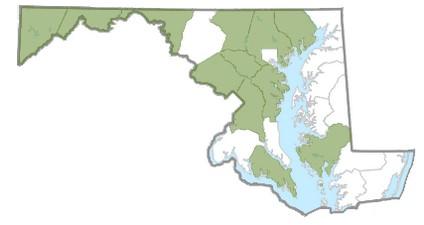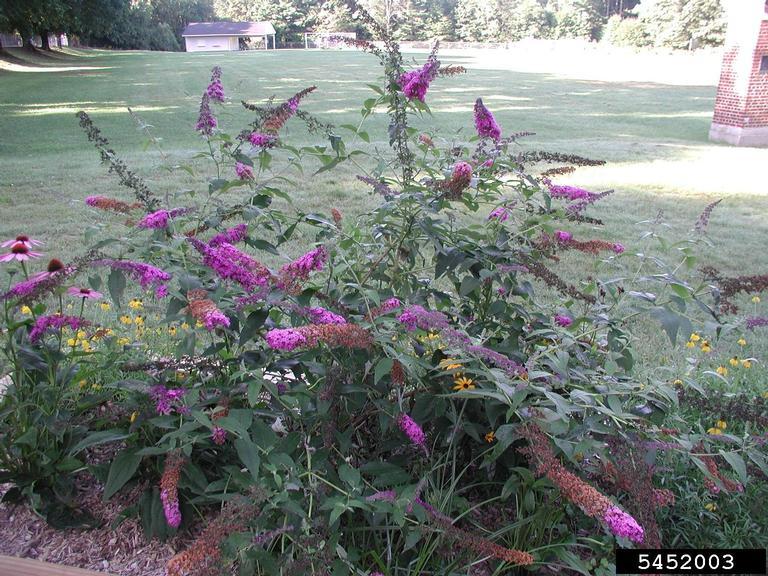A quick glance at the EDDMapS distribution map from 2019 (below) may lead the reader to surmise that the butterflybush may not be a particular problem. However, that would be an unfortunate conclusion. The butterflybush, also known as butterfly bush (two words), butterfly-bush (hyphenated), summer lilac, and Buddleia (after its taxonomic name, Buddleja davidii), is indeed an invasive species.

At that time, the plant was reported in four Maryland counties: Allegany, Washington, Prince George’s and Montgomery. By 2025, it had spread to an additional eight; see the updated map from the Maryland Biodiversity Project below.

This plant is a rarity among non-native, invasive species. It has a wide variety of cultivars and a wide range of supporters among retail outlets as well as some environmental observers. It is also benefitting from positive public relations related to the decline of butterflies. However, it is indeed invasive, and contributes to (rather than mitigates) the decline of pollinators.
The key to understanding the harm that butterflybush causes lies in understanding the role played by caterpillars. For native pollinators to survive, they need specific plant species for their larvae’s diets. Butterflybush leaves provide no nutrition for these caterpillars. Without the proper diet, the caterpillars do not survive. Additionally, birds such as chickadees that rely on caterpillars to feed to their young, will also be impacted. University of Delaware entomologist Doug Tallamy, who provided the foreword to The Woods in Your Backyard (2nd edition), outlines this relationship in brief during an interview for Good Housekeeping here.
What is it?
Butterflybush was introduced to North America from southwestern China in the early 20th century. Originally intended as an ornamental planting, it escaped into uncultivated habitats in the Northeast, Southeast, and mid-Atlantic states, as well as scattered locations in the Midwest. Today, it is also reported widely in the Pacific Northwest and southern California. It is found throughout southeastern Pennsylvania and in three counties in northern Virginia.
Given its widespread popularity as an ornamental planting, it may exist in other environments where it is not reported and is considered a beneficial plant. However, the plant has the capacity to be invasive almost anywhere. As Prof. Tallamy notes, “If it’s not in some place, chances are good it will be [at some point].” The truth is that it crowds out native plants, preferring sunny, dry, and disturbed sites with well-drained soils. It also colonizes riparian areas such as stream and river banks.
How does it spread?
Butterflybush spreads from cultivated plantings by way of seed dispersal. Each flower contains a capsule with small, dust-like seeds that opens at maturity. The seeds are dispersed in the wind and can also spread when falling into water. It does not spread via stems or roots or other vegetative methods.
How can I identify it?
Butterflybush is a woody shrub that grows 3-15 feet tall in a single season. The velvety leaves are opposite with toothed or wavy margins, and are lance-shaped and pale gray-green. It flowers from summer through fall, producing thick, wand-like clusters from the tips of the stems. The majority of flowers are purple, pink, lilac, or white, with orange centers; additional cultivars have created additional flowering colors including deep red and yellow. See the image gallery below.
How can I control it?
The easiest way to control butterflybush is to not plant it in the first place. (There are a number of native alternatives that support pollinators; see the resources below.) Established plants can be removed by digging. It is important to ensure that established flowers are removed before the seeds are dispersed.
For more information:
Learn more about butterflybush:
Butterfly Bush (University of Maryland Extension Home & Garden Information Center)
Butterflybush, Buddleja davidii (Invasive.org)
Plant Invaders of Mid-Atlantic Natural Areas: Orange-eye Butterflybush (National Park Service)
Butterfly Bush is Invasive DO NOT Plant (ecosystemgardening.com)
